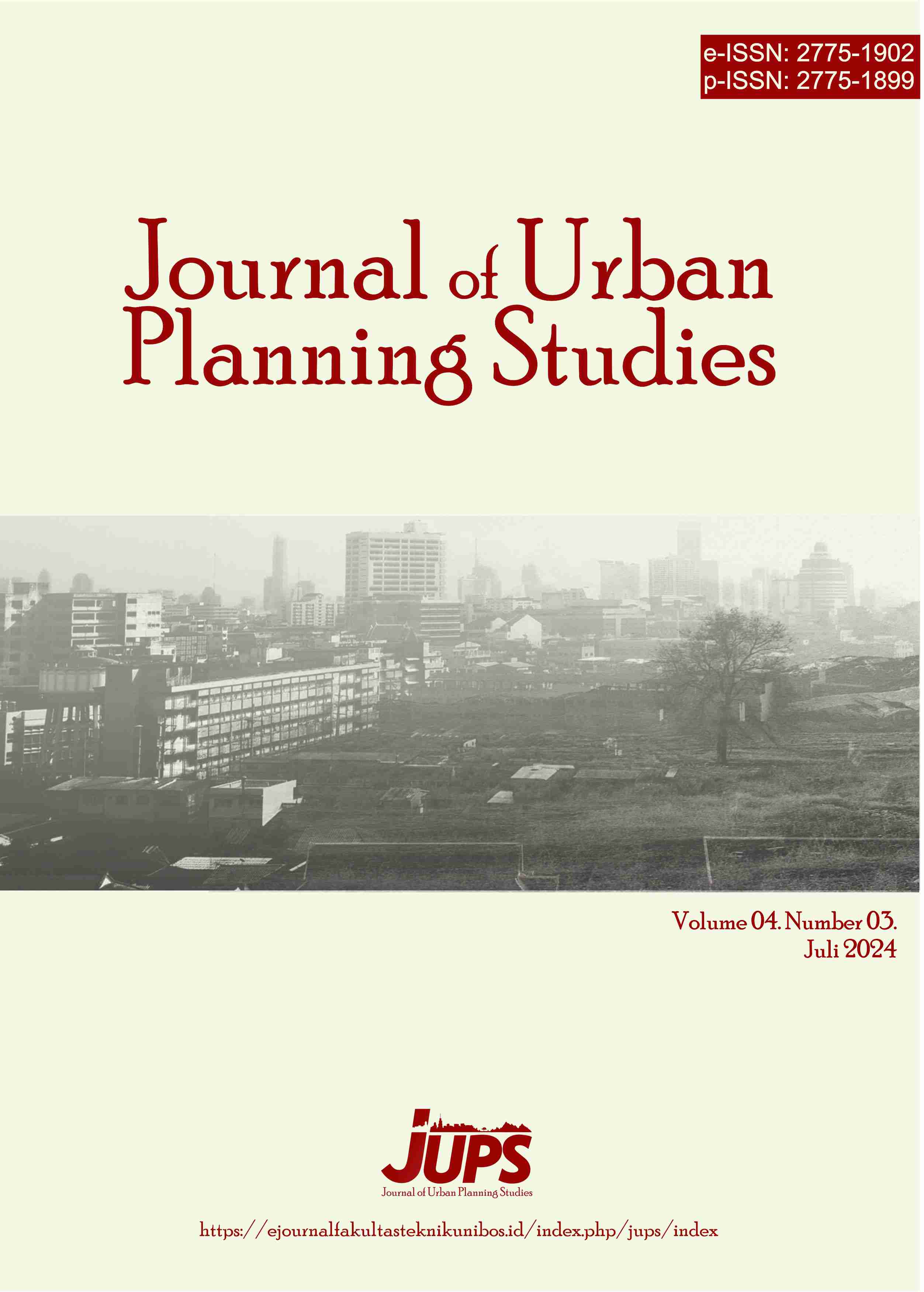Upaya Pengembangan Ruang Terbuka Hijau Dalam Mewujudkan Pembangunan Berkelanjutan di Kota Masamba
DOI:
https://doi.org/10.35965/jups.v4i3.508Keywords:
Upaya Pengembangan , Ruang Terbuka Hijau, Pembangunan BerkelanjutanAbstract
This research aims to identify the factors causing the limited availability of Green Open Spaces (GOS) in Masamba City, evaluate the impacts of this scarcity, and formulate development strategies to support sustainability. The research methodology encompasses both qualitative and quantitative approaches, involving data collection through observation, documentation, interviews, and analysis using the Green Blue Index (GBI), as well as a literature review and qualitative descriptive analysis. The study findings reveal that the availability of GOS in Masamba City, as measured by the GBI, is influenced by factors such as limited funding, restricted land availability, low community engagement, and insufficient government awareness regarding the importance of GOS. Qualitative analysis also identifies adverse consequences of the GOS shortage, including increased air pollution, reduced rainwater absorption capacity, and higher temperatures. Efforts to develop GOS must consider economic, social, and environmental aspects of sustainable development. This includes wise financial allocation, efficient land management, increased community participation, and heightened awareness and education about the benefits of GOS for the environment and community well-being. This research provides valuable insights for policymakers and the Masamba City community to enhance the availability of Green Open Spaces and effectively integrate them into urban development planning to achieve comprehensive sustainable development goals.
References
Bowler, D. E., Buyung-Ali, L., Knight, T. M., & Pullin, A. S. (2010). Urban greening to cool towns and cities: A systematic review of the empirical evidence. Landscape and Urban Planning, 97(3), 147-155.
Bryman, A. (2022). Social Research Methods. Oxford University Press.
Byrne, J., & Sipe, N. (2010). Green and open space planning for urban consolidation–A review of the literature and best practice. Urban Research Program, Griffith University.
Colding, J., Lundberg, J., & Folke, C. (2013). Incorporating green-space into urban planning for human health and biodiversity protection. Bioscience, 63(8), 571-578.
Coutts, C., & Hahn, M. (2015). Green Infrastructure, Ecosystem Services, and Human Health. International Journal of Environmental Research and Public Health, 12(8), 9768-9798.
Creswell, J. W., & Poth, C. N. (2023). Qualitative Inquiry and Research Design: Choosing Among Five Approaches. SAGE Publications.
Dennis, M., & James, P. (2016). User participation in urban green commons: Exploring the links between access, voluntarism, biodiversity and well-being. Urban Forestry & Urban Greening, 15, 22-31.
Gill, S. E., Handley, J. F., Ennos, A. R., & Pauleit, S. (2007). Adapting cities for climate change: The role of the green infrastructure. Built Environment, 33(1), 115-133.
Gómez-Baggethun, E., & Barton, D. N. (2023). Urban Ecosystem Services and Green Infrastructure: A Review of the Recent Literature. Urban Forestry & Urban Greening, 68, 127-140.
Haaland, C., & van den Bosch, C. K. (2015). Challenges and strategies for urban green-space planning in cities undergoing densification: A review. Urban Forestry & Urban Greening, 14(4), 760-771.
Haase, D., Kabisch, N., & Haase, A. (2022). Urban Green Spaces as a Component of an Integrated Urban Resilience Strategy. Ecological Indicators, 145, 109-124.
Jones, A., Brown, B., & Williams, C. (2023). The Impact of Urban Green Spaces on Environmental Quality and Public Health. Journal of Urban Planning and Development, 149(2), 123-135.
Kabisch, N., & Haase, D. (2014). Green justice or just green? Provision of urban green spaces in Berlin, Germany. Landscape and Urban Planning, 122, 129-139.
Kabisch, N., Qureshi, S., & Haase, D. (2016). Human–environment interactions in urban green spaces—a systematic review of contemporary issues and prospects for future research. Environmental Impact Assessment Review, 50, 25-34.
Kvale, S., & Brinkmann, S. (2022). InterViews: Learning the Craft of Qualitative Research Interviewing. SAGE Publications.
Nowak, D. J., Hirabayashi, S., Bodine, A., & Greenfield, E. (2014). Tree and forest effects on air quality and human health in the United States. Environmental Pollution, 193, 119-129.
Peraturan Daerah Kabuaten Luwu Utara No. 06 Tahun 2016 Tentang Rencana Detail Tata Ruang dan Peraturan Zonasi Kawasan Perkotaan Masamba Tahun 2016-2036
Peraturan Daerah Kabupaten Luwu Utara No. 7 Tahun 2016 Tentang Pengelolaan Ruang Terbuka Hijau Bagian Wilayah Perkotaan Masamba Tahun 2016-2036
Peraturan Menteri Agraria dan Tata Ruang/Kepala Bidan Pertanahan Nasional Nomor 14 Tahun 2022 tentang Penyediaan dan Pemanfaatan Ruang Terbuka Hijau.
Peraturan Menteri Dalam Negeri No. 1 Tahun 2007 tentang Penataan Ruang Terbuka Hijau Kawasan Perkotaan.
Smith, D., & Lee, H. (2022). Urban Green Spaces as Ecological Corridors: Implications for Biodiversity and Urban Planning. Environmental Science & Policy, 136, 102-115.
Soemarwoto, O. (2004). Pembangunan Berkelanjutan: Konsep dan Prinsip. Penerbit: Penerbit Universitas Indonesia.
Webster, J., & Watson, R. T. (2022). Analyzing the Past to Prepare for the Future: Writing a Literature Review. MIS Quarterly.
Wolch, J. R., Byrne, J., & Newell, J. P. (2014). Urban green space, public health, and environmental justice: The challenge of making cities ‘just green enough’. Landscape and Urban Planning, 125, 234-244.
Yin, R. K. (2023). Case Study Research and Applications: Design and Methods. SAGE Publications.
Yunus, H., Santoso, D., & Putra, M. A. (2023). Application of Indonesia Hijau Biru Analysis in Urban Planning. Journal of Urban Development, 156(3), 145-160.
Downloads
Published
How to Cite
Issue
Section
License
Copyright (c) 2024 Jihad Syahid Ardillah, Rahmawati Rahman, Jufriadi, Alwan

This work is licensed under a Creative Commons Attribution 4.0 International License.













